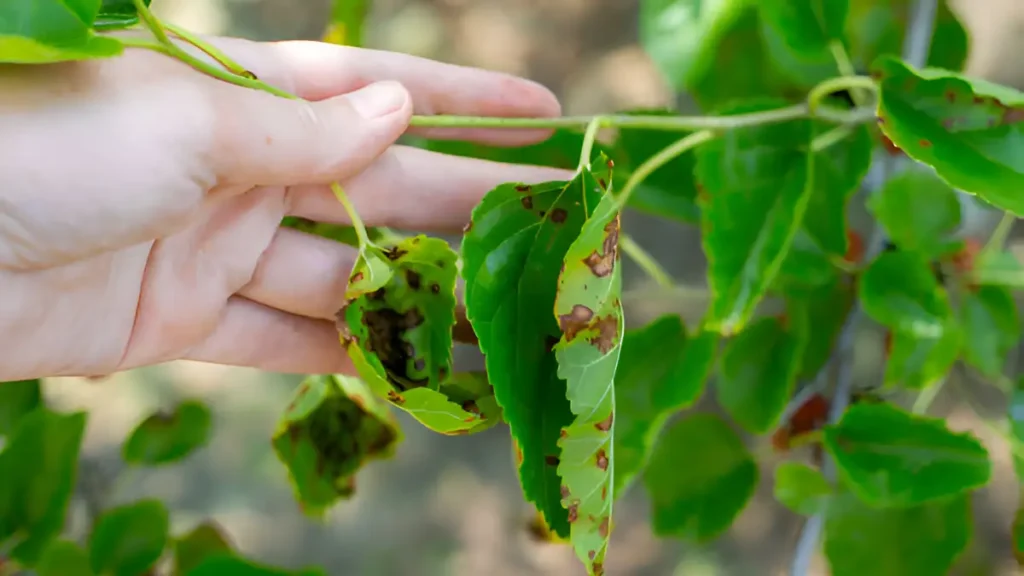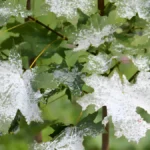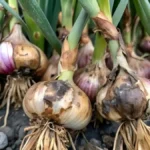The term “leaf spot disease” describes a class of plant illnesses that are defined by the development of spots on the leaves. Different bacterial, viral, or fungal infections usually bring on these diseases. These patches can differ in size and shape, and as the disease progresses, they may turn brown, black, or yellow. Early spring is a chilly, damp time of year when leaf spots on plants are most likely to appear. This article will provide some guidance on leaf spot diseases, their causes, and treatment methods.
Causes and identification of leaf spots:
A typical plant issue that several sources can bring on is leaf spots. Here are specifics regarding the origins of spots and how to recognize them.
Leaf spot disease:
- While bacteria or other pathogens can also cause leaf spot disorders, fungi are the primary cause of most illnesses. Typically, fungus leaf spots manifest as tiny, spherical, black blemishes. Since the lower and inner branches have more humidity and darkened leaves, this is typically where leaf spot illnesses are first noticed.
- Leaf spots are a result of bacterial pathogens like Xanthomonas and Pseudomonas. Often seeming water-soaked, bacterial leaf patches eventually turn dark brown or black as they dry. The angular, rounded, raised, buried, and fringed margins of leaf spots are all possible.
- Tobacco mosaic virus, for example, can cause leaf patches. Viral spots frequently have a strange shape. Signs of the disease, such as fungal spores or spore-producing structures, can be seen in the center of bigger leaf patches.
- As they consume plant tissues, pests like thrips and aphids can leave marks on plants. The pathogens that produce leaf spots are blown by the wind, splashed by rain, or irrigated leaves, causing spots to appear randomly on their surface. Spots formed by insects frequently have additional indicators of pest activity.

Learn how to treat leaf spot disease:
Leaf spot disease must be properly cared for and, if required, treated with chemicals. Below are a few of his directives.
Leaf spot disease treatment:
- Determine the disease’s cause first. Remove and dispose of impacted foliage to stop the illness from spreading. To prevent leaf spot infections from spreading, keep leaves as dry as possible. These diseases need moisture to thrive. After trimming, use a disinfectant to clean gardening tools and stop the disease from spreading.
- In particular, during the dry summer months, water your tree frequently during the growing season to keep the top 6 to 8 inches of soil damp. Keep the mulch layer surrounding your tree 3 to 4 inches deep. Clean any fallen leaves from the spaces surrounding trees and bushes, especially in the fall. To keep leaves dry, remove any branches that are severely affected and refrain from watering from above.
- Use a suitable fungicide if the illness is fungal. Typical choices are neem oil, chlorothalonil, or fungicides with a copper base. Observe the dosage and frequency instructions on the label. Additionally, a neem oil spray can help prevent leaf spots after all afflicted areas have been removed.
- Until a soil test indicates that fertilizing is necessary to address a nutrient deficiency, do not treat trees and shrubs that have leaf spot diseases. Balanced fertilization can help plants stay healthy by strengthening their defenses against disease. Keep an eye out for any new infection-related symptoms in your plants and repeat therapy as needed.
- Large trees require high-pressure spraying equipment to completely cover their canopy. Fertilize your plants in a balanced way to keep them healthy and potentially resistant to disease. For large trees, treating leaf spot disease may require hiring a qualified arborist.
Conclusion:
Leaf spot disease is a prevalent plant disease that can be brought on by several pathogens, such as bacteria, fungi, and occasionally viruses. Small, discolored spots on leaves are usually how they show up, and this might cause early leaf drop. The reduction of leaf spot disease’s negative effects on plants depends on routine observation and prompt action. You may manage and avoid leaf spot disease in your plants by following the above-mentioned strategies.
Certainly! If you’d like to learn more, please consider following our WhatsApp Channel: Harvest Gardening
A frequently asked questions:
Q1. What is leaf spot disease?
A1. Plant leaves with brown spots on them are a sign of Leaf Spot Disease, a fungal or bacterial illness. Based on the pathogen in question, these spots may differ in size, shape, and color.
Q2. What is the method for bacterial leaf spot treatment?
A2. To prevent infection spread, remove and destroy diseased leaves, apply copper-based fungicides every seven to ten days, and choose plant cultivars resistant to disease.
Q3. What are ash leaf spots?
A3. Ash leaf spots are circular or irregular patches that form on the leaves of ash trees. They are frequently caused by fungal diseases or environmental stress. If severe, they usually have a bright or dark core and might result in leaf drop.
Q4. How to treat leaf spot disease on houseplants?
A4. Treat leaf spot disease by removing affected leaves, increasing air circulation, and not watering plants from above. If necessary, apply a fungicide to prevent spread.
Q5. What causes leaf spot disease in Pothos plants?
A5. Bacterial infections or fungal diseases such as Phyllosticta are the main causes of leaf spot disease in Pothos. Poor ventilation and overwatering may have a role in its development.



